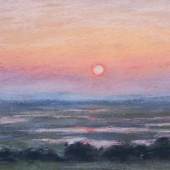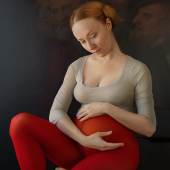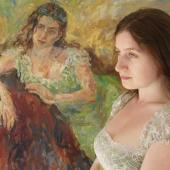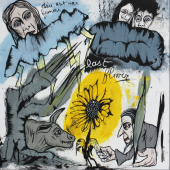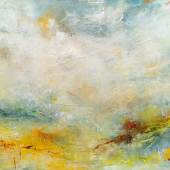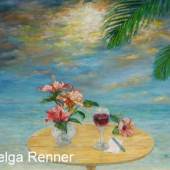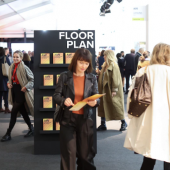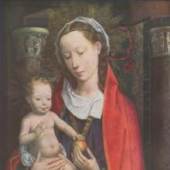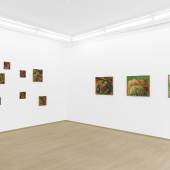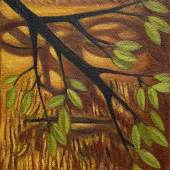Galerie Nosbaum Reding
Nat Meade Creeper, Sleeper, Weeper
-
Ausstellung20.06.2024 - 14.09.2024
Over the last decade, the American painter Nat Meade has developed a unique style of portraiture within the genre of so-called ‘allegorical autofiction’. In his works, a recurring bearded protagonist embodies emotional states the artist has personally experienced in certain phases of his life or social roles as a man. Their brightly coloured motifs do not refer to external but internal states, while symbolic attributes reinforce the slightly quaint atmosphere that pervades the works. The archetypal monolithic head, which Meade occasionally depicts in bust length or in pairs or threes within the same painting, harkens back to the artist’s early memory of a woodcut portrait of Walt Whitman (1819–1892) by Antonio Frasconi that hung in his parents’ home — an informal, expressive head with a triangular nose, its full beard rendered by large, thick strokes. Meade, who grew up in the Pacific Northwest region of the United States, is well familiar with such rugged physiognomies. In his writings, Whitman, arguably the most famous American poet of the nineteenth century, chastised the upheavals and divisions in modern society, instead romanticising the declining agrarian model and its social cohesion. Even in the twenty-first century, the myths of the founding of the United States and the conquest of the West still inform the country’s understanding of traditional male roles — an outdated cliché, for many reasons. Meade expresses his own unease at this conception through the tongue-in-cheek fatalism of his archaic figures who, despite their robust appearance, seem vulnerable, exhausted, oblivious of the world around them and at times tender, and are often shown sleeping, pondering or crying. Sometimes their detached heads, lying flat on the floor, even transform into objects that tie in with the surrounding natural landscape. Meade varies the pictorial space by playing with different viewing distances and angles. In his smaller works (such as Basal, Scrim, Canopy), the face appears as if seen through a telephoto lens, filling the entire pictorial space, with even the chin, forehead or cheeks cropped. This leaves no room for peripheral attributes, so that all additions, such as branches with green or autumn-brown leaves, overlap and obscure the face. The relationship between nature and the individual is thus reversed; what we see is not humans who stand or act in nature, but nature that conceals the humans and turns them into a mere backdrop, into something passive. In Meade’s medium-size formats (such as Creeper, Sleeper, Weeper) or the large format Dandylion, the extended angle embraces the surroundings of the person, who is always pictured in the centre ground, leaving space in the background for a hill, a decomposing log or shallow water. The foreground can therefore accommodate (mostly vegetal) elements that are in turn orientated towards the figure, such as dandelion flowers stretching their stems like curious antennae. The prehistoric faces rarely look directly at the viewer — in most cases their eyelids are closed or the pupils are turned thoughtfully to the side. Their mysterious appearance lends them an oracular quality that invites viewers to make them ‘speak’ through their own reflections.
Besides their unusual and subtle, almost burlesque motifs, the colour treatment is a distinctive feature of Meade’s paintings — even his works on paper radiate as if they had built-in backlighting. This effect is achieved through a clever distribution of light in the composition of the motifs: imaginary light sources cast deep shadows on certain objects, while other areas reflect the light and seem to glow from within. In contrast, the surfaces of the paintings are rough and matte — the exact opposite of a high-gloss sheen. The artist uses mainly jute or hemp as canvases, literally slaving away at the harsh texture. Layers of colour are applied but also scraped off again before being reconstructed again, the slow, layered build-up resulting in highly saturated colours. In addition, Meade only uses colour tones that shine in the lighter parts of the painting and transform into radiant dark tones in the shadowy ones: yellow turns to orange or green, pink becomes violet. The weft of the fabric is still clearly visible in the finished picture, creating the impression of a gauze through which we view the strongly lit motif, as though on a theatre stage.
Sabine Dorscheid
-
11.11.2022 - 13.11.2022Für ihre achte Ausgabe der Luxembourg Art Week wurden die Ausstellungsflächen und Servicebereiche...
-
18.09.2024 - 09.11.2024Tina Gillen ist eine zeitgenössische luxemburgische Künstlerin, die für ihre farbintensiven...
-
10.11.2023 - 12.11.2023Bei der 9. Ausgabe der Luxembourg Art Week, die vom 10. bis 12. November 2023 (Preview: 9....
-
Die Galerie Nosbaum Reding ist eine renommierte Kunstgalerie in Luxemburg, die sich auf...
-
Die erste offizielle Registrierung von Memling Hans ist der Eintrag ins Register der Stadt Br...
-
20.06.2024 - 14.09.2024
Wednesday-Saturday 11 am - 6 pm
